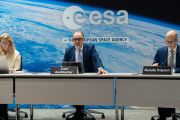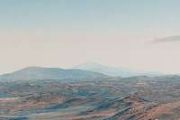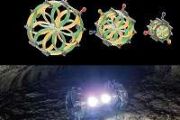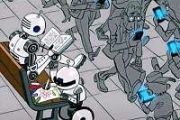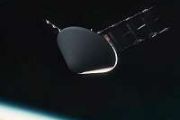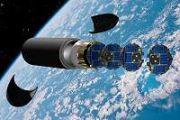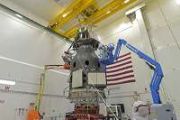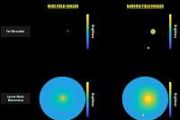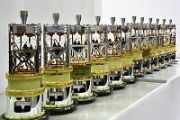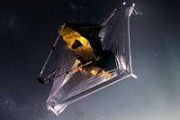
Copernical Team
NASA changes Starliner contract: First ISS mission to carry only cargo
 Boeing's Starliner spacecraft will only fly cargo to the International Space Station after NASA changed the contract with Boeing that also cut the number of missions for the craft.
On Monday, NASA announced the update to the 2014 contract. It originally said there would be six crewed flights to the ISS after a successful uncrewed flight test. Now the contract says the total will be four mi
Boeing's Starliner spacecraft will only fly cargo to the International Space Station after NASA changed the contract with Boeing that also cut the number of missions for the craft.
On Monday, NASA announced the update to the 2014 contract. It originally said there would be six crewed flights to the ISS after a successful uncrewed flight test. Now the contract says the total will be four mi Chang'e-6's far-side lunar samples show strongly cohesive behavior
Verifying that you are not a bot
From orbit to X-ray: Imaging the entire EURECA satellite to reveal hidden structural damage
Verifying that you are not a bot
SpainSat NG programme completed as second secure communications satellite launches

Europe has strengthened its secure-communications capabilities with the successful launch of SpainSat NG II on 24 October, wrapping up the SpainSat Next Generation programme supported by the European Space Agency (ESA). With both SpainSat NG satellites now in orbit, Europe will see its most advanced governmental communications system to date, a major step for the continent’s security, crisis-response capacity, and technological autonomy.
CM25 priorities for Space Transportation Systems
 Video:
00:04:06
Video:
00:04:06
On 26–27 November, the ESA Ministerial Council will take place in Bremen, Germany. Key decisions will be made about the future activities of the European Space Agency within the frame of ESA’s Strategy 2040. Toni Tolker-Nielsen outlines how these decisions will shape the future of Space Transportation Systems.
Ancient deep ocean rocks shown to be long-term carbon storage reservoirs
 Rock samples collected from beneath the Atlantic Ocean reveal that lava rubble accumulating on the seafloor can store carbon dioxide for tens of millions of years. Research led by the University of Southampton involved analyzing lava cores extracted during the International Ocean Discovery Program's Expedition 390/393. The study focused on breccias, rocks created from eroded seafloor mountains a
Rock samples collected from beneath the Atlantic Ocean reveal that lava rubble accumulating on the seafloor can store carbon dioxide for tens of millions of years. Research led by the University of Southampton involved analyzing lava cores extracted during the International Ocean Discovery Program's Expedition 390/393. The study focused on breccias, rocks created from eroded seafloor mountains a Ethiopian volcanic plume
 Image:
The Hayli Gubbi volcano in northeast Ethiopia, dormant for up to 12 000 years, erupted on 23 November 2025, sending a large plume of ash and sulphur dioxide into the atmosphere. Copernicus Sentinel-5P captured the spread of the sulphur dioxide.
Image:
The Hayli Gubbi volcano in northeast Ethiopia, dormant for up to 12 000 years, erupted on 23 November 2025, sending a large plume of ash and sulphur dioxide into the atmosphere. Copernicus Sentinel-5P captured the spread of the sulphur dioxide. Mitigating radio frequency interference in US weather satellites
 As the National Oceanic and Atmospheric Administration prepares to launch the next generation of satellites responsible for U.S. weather forecasting and climate monitoring, it's asking researchers for help ensuring accurate measurements in the face of growing radio frequency interference from wireless technologies.
Mustafa Aksoy, an associate professor in UAlbany's College of Nanotechnolog
As the National Oceanic and Atmospheric Administration prepares to launch the next generation of satellites responsible for U.S. weather forecasting and climate monitoring, it's asking researchers for help ensuring accurate measurements in the face of growing radio frequency interference from wireless technologies.
Mustafa Aksoy, an associate professor in UAlbany's College of Nanotechnolog Hyperspectral Microwave Sounder Set for Launch Following Final Testing Phase
 Spire Global, Inc. has completed environmental testing, calibration, and flight qualification for its Hyperspectral Microwave Sounder (HyMS) payload, which is now integrated into a Spire 16U satellite and shipped to Vandenberg Space Force Base for launch aboard SpaceX's Falcon 9 Twilight mission.
The HyMS payload will serve as a technology demonstrator, aiming to validate the function of a
Spire Global, Inc. has completed environmental testing, calibration, and flight qualification for its Hyperspectral Microwave Sounder (HyMS) payload, which is now integrated into a Spire 16U satellite and shipped to Vandenberg Space Force Base for launch aboard SpaceX's Falcon 9 Twilight mission.
The HyMS payload will serve as a technology demonstrator, aiming to validate the function of a Ancient giant shark fossils reveal early mega-predator dominance in Australian seas
 Researchers have identified fossils of a gigantic lamniform shark that lived off northern Australia 115 million years ago. This predator achieved massive body size much earlier in shark evolutionary history than previously known, taking a leading position in ocean food chains with large marine reptiles. The discovery emerged from an interdisciplinary analysis reconstructing size evolution in anc
Researchers have identified fossils of a gigantic lamniform shark that lived off northern Australia 115 million years ago. This predator achieved massive body size much earlier in shark evolutionary history than previously known, taking a leading position in ocean food chains with large marine reptiles. The discovery emerged from an interdisciplinary analysis reconstructing size evolution in anc 
